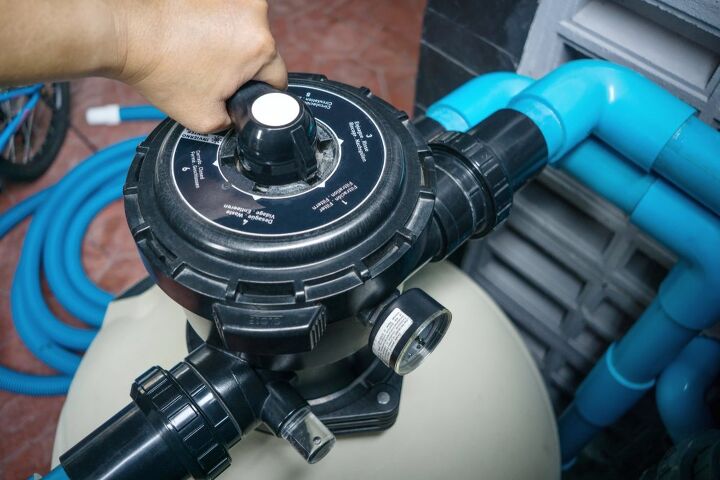Pool Filter Blowing Out Sand or Dirt (We Have a Fix!)

Pool filters serve a single purpose: get rid of impurities in the pool. Plain and simple, right? Well, sometimes what they are supposed to do isn’t the thing that they are doing. If you recently noticed your pool filter burping out sand, it’s clear something isn’t right. It’s not supposed to do that! But, why is it blowing out sand like it’s going out of style?
Sand blowing out of your filter only really happens if you have a sand filter. When this occurs, it means that a main component of your filter broke. The three components that most commonly cause this issue include a broken standpipe, a lateral pipe, or a busted seal. You need to remove and replace the broken part.
A lot of people tend to make the assumption that you will need to replace the filter. In many cases, this is a good idea, but not necessary. Keep reading to find out what you need to do.
Do You a Need Pool, Spa, or Hot Tub Contractor?
Get free, zero-commitment quotes from pro contractors near you.

Before You Begin: Get Prepared
Before you begin, it’s important to remember that you will need to work with a new batch of sand. Sand filters can’t just be repaired without replacing the sand. So, check how much your filter’s sand capacity is, and buy that sand. Most filters will require 150 to 350 pounds of the stuff. You also will need to make sure you have the resources to discard the rest of the stuff correctly.
What Kind Of Sand Should You Buy For Your Pool Filter?
While it might be tempting to cut corners and buy playground sand for your pool filter, it’s not a good idea. You will need to buy #20 pool-grade silica sand for it. Quikrete, HTH, and Clorox all have this type of sand. It’s made from silica quartz, which means that the jagged edges of the crystal will trap the impurities of the water more efficiently.
How Much Does Pool Filter Sand Cost?
If you are worried about having to spend a fortune on sand, don’t be. It’s relatively cheap. You can get a 50-pound bag of high-quality pool sand for $10 to $17 dollars. This means that a typical 150-pound filter won’t cost more than $75 to fill up.
When Should You Simply Replace The Pool Filter?
For the most part, a filter that’s spraying sand generally doesn’t need to be replaced. However, you might still want to do it if the price of repairing the filter is more than half the price of a new filter. In most situations, this won’t be the case. However, if you notice that your filter has multiple issues, it might be too old to hold up well in the future.
A good rule of thumb is that you should consider replacing your pool filter every six to eight years. People who have had their pool filter for years on end might need to take this as a sign that it’s time to get a new filter. If you aren’t sure of the age of the filter, it might still be a good idea to switch it out for a new model.
If your pool filter is relatively new, you should consider calling up the manufacturer if it’s still under warranty. You might have a defective filter and should get it replaced for free.
How To Troubleshoot A Pool Filter That’s Blowing Out Sand
Now that we’ve given you a heads up on the warning, let’s talk about how you can troubleshoot this issue…
1.Begin by prepping your filter.
Turn the water off to the filter and let it drain dry. Your filter needs to be dry and water-free before you start taking it apart. Once it’s dry, you can move onto step number 2.
2.Remove the collar holding the assembly flush with the top of your filter.
Unscrew any unions that are keeping them together. If you do not have any unions on your filter, you will have to cut off the area near where the filter gets piped in. You also will need to measure the area to find out what unions you will need to buy in order to re-install the filter.
3.Remove the multi-port assembly.
When you remove the assembly, use duct tape or another type of cap on the standpipe to prevent the sand from leaking out. If any sand spills, use a vacuum to suck it all up. Then, remove all the sand from the filter. (You might need a wheelbarrow for this, especially if it’s a very large filter.)
4.Lift the standpipe and take a look inside.
To do this, start by looking at all the pipes inside the filter. You will need to pull out the standpipe which supports the majority of the filter, and then replace whatever needs to be replaced.
- Pull out the manifold. The manifold is the “starburst’ part that holds all the pipes at the bottom of the filter. Remove the manifold and check out how it looks. You may need to softly bend the lateral pipes to do so. Don’t worry, it’s totally okay. They’re meant to bend.
- Check your laterals. The laterals are the pipes arranged like a starburst at the bottom of the filter. If you notice that one of the lateral pipes is cracked, that’s the pipe that you will need to replace.
- Then, double-check the standpipe itself. In most cases, it’ll be fine. Otherwise, you will need to replace that part.
- Finally, check all the seals that are inside and around your filter. The seals are the easiest things to replace. Here’s hoping that you only have to replace this.
5.Once you have replaced the parts that are broken, you will need to replace the sand in the filter.
This will be a bit tricky. You will need to piece together the standpipe and manifold together first. Once it’s been reassembled, do the following:
- Double-check that your filter’s interior has been properly reassembled. Make sure nothing has gaps or cracks left in it. Otherwise, all your work will be for naught.
- After that, gently place the filter interior in the center of the filter. Hold it in place, and then fill half of the filter with water. This will help prevent any damage from the sand. Use clean, filtered water if possible.
- Fill the filter with the appropriate amount of sand. Keep the standpipe steady when you do this. If you need to, call a friend so that you have that extra hand.
- Remove the tape from the top of the standpipe. The standpipe should be clear of sand at this point.
6.Reinstall the standpipe to the multi-port assembly.
When you’re reinstalling everything, check the O-ring and washer unions around the assembly. If it’s worn out, replace it. This often can be another cause of a leaky filter, so you might as well double-check everything. After you reinstall everything, seal everything up and add unions to join the piping together if you need to.
7.Run the filter to help remove any additional debris.
Even the tiniest of repairs will cause your sand pool filter to have some mess. To clear everything up, set your pool filter to backwash and run it for three to five minutes. Then, set the filter to a rinse cycle and have it run for an additional couple of minutes. From here, you should be good to go.
Do You a Need Pool, Spa, or Hot Tub Contractor?
Get free, zero-commitment quotes from pro contractors near you.

Related Questions
Will a sand filter catch all the algae in my pool?
While sand filters are highly efficient at removing most impurities, the truth is that algae happens to be a weak spot of theirs. Due to the size of certain algae particles, you cannot rely on sand filters to catch 100 percent of the algae in your pool. To get rid of all the algae in your pool, turn off the filter and pump and let it rest for 24 hours. Then, use a vacuum to suck the algae off the bottom of the pool.
How can you tell if you put too much sand in your pool filter?
If you put too much sand in your pool filter, there is a good chance that you won’t actually be able to close the filter. If you are able to put it together, then you will quickly notice that the filter doesn’t quite run correctly. It may be too noisy, or it may not actually be able to filter everything you have in the pool. In rare cases, your filter might break during reassembly if too much sand is put inside of it.
How much sand should a pool filter have inside of it?
Many people wrongfully assume that a pool filter needs to be filled to the brim with sand. This is not true. To get the most out of your pool filter, you only need to fill it 2/3 full. So if your pool filter has 150 gallons of space, it’ll need to have 100 gallons of sand. With that said, you shouldn’t worry about this. In most cases, you will be able to find how much sand your specific filter requires by searching up the model online.

Ossiana Tepfenhart is an expert writer, focusing on interior design and general home tips. Writing is her life, and it's what she does best. Her interests include art and real estate investments.
More by Ossiana Tepfenhart
















![Cost To Drill A Well [Pricing Per Foot & Cost By State]](https://cdn-fastly.upgradedhome.com/media/2023/07/31/9074980/cost-to-drill-a-well-pricing-per-foot-cost-by-state.jpg?size=350x220)










